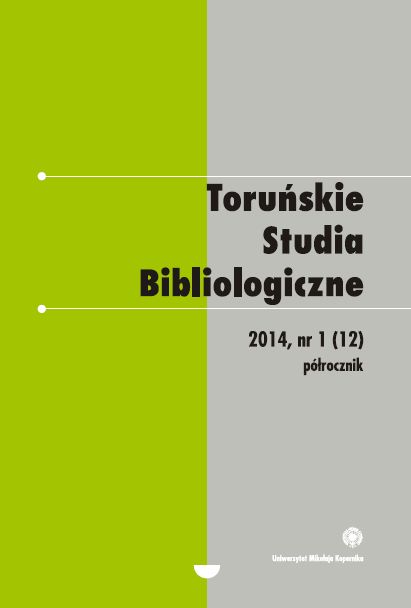New Media and Technologies of Identity. Lifestreaming as a Socio-cultural Practice
DOI:
https://doi.org/10.12775/TSB.2014.009Keywords
lifestreaming, new communication technologies, reality mining, re-edition of SelfAbstract
The paper is devoted to a theoretical analysis of the phenomenon of lifestreaming – a specific socio-cultural practice embedded in the reality of new communication technologies. To lifestream means to leave digital traces of self online, broadcast self-related content, (auto)explore one’s identity presenting it at the same time to a networked audience. Due to affordances of new communication technologies their users have the opportunity to share with others diverse content as well as manage their presence in social networking platforms in the realm of mobile media. The paper analyzes both the analytical background and the social context of the depicted practice as well as potential future scenarios of the evolution of the phenomenon researched today by social scientists.References
Bauman Zygmunt, Żyjąc w czasie pożyczonym, Kraków 2010.
Bellah Robert N., Madsen Richard, Sullivan William M., Swidler Ann, Tipton Steven M., Skłonności serca. Indywidualizm i zaangażowanie po amerykańsku, Warszawa 2007.
Brin David, The Transparent Society: Will Technology Force Us To Choose Between Privacy And Freedom?, New York 1998.
Domaszewicz Zbigniew, Świergot zdechłej wrony, „Polityka” [online] 5.06.2009 [dostęp 31 maja 2014]. Dostępny w World Wide Web: http://www.polityka.pl/nauka/komputeryiinternet/293142,1,swiergot--zdechlej-wrony.read.
Fortunati Leopoldina, Taipale Sakari, Luca Federico de, What happened to body-to-body sociability?, „Social Science Research” 2013, Vol. 42, No. 3, s. 893–905.
Gergen Kenneth, Nasycone Ja. Dylematy tożsamości w życiu współczesnym, Warszawa 2009.
Hamilton Jillian G., Ourplace: the convergence of locative media and on-line participatory culture [online]. QUT Digital Repository [dostęp 31 maja 2014]. Dostępny w World Wide Web: http://eprints.qut.edu.au/29702/1/c29702.pdf.
Kopecka-Piech Katarzyna, Mobilne media miejskie, „Studia Medioznawcze” 2012, nr 3, s. 111–125.
Krzyżaniak-Gumowska Aleksandra, Słit focia z lemingu, „Newsweek” [online] 2013, nr 30 [dostęp 31 maja 2014]. Dostępny w World Wide Web: http://polska.newsweek.pl/slit-focia-z-lezingu,106602,1,1.html.
Lewicki Grzegorz, Fejs-frustracja, „Wprost” [online] 2013, nr 37 [dostęp 31 maja 2014]. Dostępny w World Wide Web: http://www.wprost.pl/ar/415948/Fejs-frustracja/.
Ling Rich, New Tech, New Ties: How Mobile Communication is Reshaping Social Cohesion, Cambridge 2008.
Marwick Alice E., Status Update: Celebrity, Publicity and Self-Branding in Web 2.0 [online]. New York: New York University, Department of Media, Culture, and Communication, 2010, 511 s. [dostęp 31 maja 2014]. Dostępny w World Wide Web: http://www.tiara.org/blog/wp-content/uploads/2010/09/marwick_ dissertation_statusupdate.pdf.
O’Reilly Tim, Pahlka Jennifer, The ‘Web Squared’ Era, „Forbes” [online] 24.09.2009 [dostęp 31 maja 2014]. Dostępny w World Wide Web: http://www.forbes.com/2009/09/23/web-squared-oreilly-technology-breakthroughs-web2point0.html.
Personal, Portable, Pedestrian: Mobile Phones in Japanese Life, ed. by Mizuko Ito, Misa Matsuda i Daisuke Okabe, Cambridge 2006.
Rainie Lee, Wellman Barry, Networked: The New Social Operating System, Cambridge 2012.
Reichelt Leisa, Ambient Intimacy, [w:] Disambiguity [online] March 1, 2007 [dostęp 31 maja 2014]. Dostępny w World Wide Web: http://www.disambiguity.com/ambient-intimacy.
Ruppert Evelyn, Law John, Savage Mike, Reassembling Social Science Methods: The Challenge of Digital Devices, „Theory, Culture, Society” 2013, Vol. 30, No. 4, s. 22–46.
Schonfeld Erick, Mining the Thought Stream, [w:] TechCrunch [online] February 15, 2009 [dostęp 31 maja 2014]. Dostępny w World Wide Web: http://techcrunch.com/2009/02/15/mining-the-thought-stream/.
Souza e Silva Adriana de, From Cyber to Hybrid. Mobile Technologies as Interfaces of Hybrid Spaces, „Space and Culture” 2006, Vol. 9, No. 3, s. 261–278.
Stachura Krzysztof, Jak porzucić codzienny rytuał, czyli 24 godziny bez mediów, [w:] Kreacje i nostalgie. Antropologiczne spojrzenie na tradycje w nowoczesnych kontekstach, pod red. Doroty Rancew-Sikory, Grażyny Woronieckiej, Cezarego Obracht-Prondzyńskiego, Warszawa 2009, s. 360–371.
Tufekci Zeynep, Can You See Me Now? Audience and Disclosure Regulation in On-line Social Network Sites, „Bulletin of Science, Technology & Society” 2008, Vol. 28, No. 1, s. 20–36.
Turkle Sherry, Alone Together. Why We Expect More from Technology and Less from Each Other, New York 2011.
Urry John, Mobility and proximity, „Sociology” 2002, Vol. 36, No. 2, s. 255–274.
Wanke Michał, Internet i nowe indywidualne i masowe formy uczestnictwa [online]. Slideshare [dostęp 31 maja 2014]. Dostępny w World Wide Web: http://www.slideshare.net/wankz/internet-i-nowe-indywidualne-i-masowe-formy-uczestnictwa.
Downloads
Published
How to Cite
Issue
Section
Stats
Number of views and downloads: 681
Number of citations: 0



